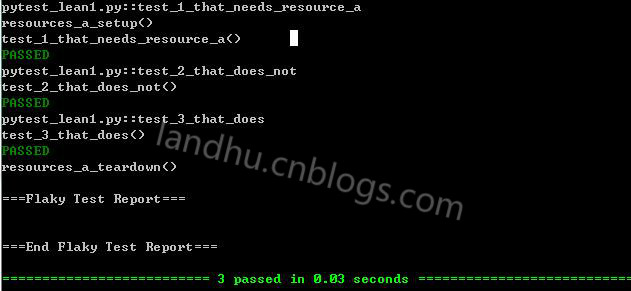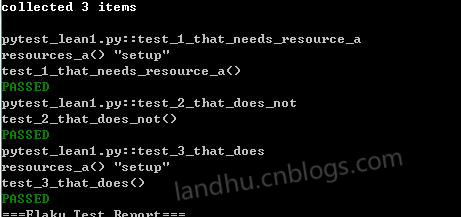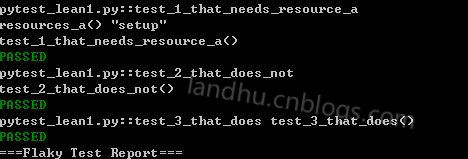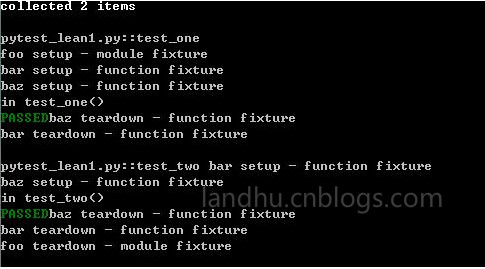python pytest测试框架介绍三
之前介绍了pytest以xUnit形式来写用例,下面来介绍pytest特有的方式来写用例
1、pytest fixture实例1
代码如下
from __future__ import print_function
import pytest @pytest.fixture(scope='module')
def resource_a_setup(request):
print('\nresources_a_setup()')
def resource_a_teardown():
print('\nresources_a_teardown()')
request.addfinalizer(resource_a_teardown) def test_1_that_needs_resource_a(resource_a_setup):
print('test_1_that_needs_resource_a()') def test_2_that_does_not():
print('\ntest_2_that_does_not()') def test_3_that_does(resource_a_setup):
print('\ntest_3_that_does()')
使用-s -v运行查看详情如下

这里使用的了pytest的特有的模式来写用例,使用的方式是scope方式,scope支持多种,后面会介绍
这里还使用了pytest的addfinalizer内置功能,具体可参见官网,用处是:在最后一个测试项目中调用teardown
2、pytest fixture实例2
代码如下
from __future__ import print_function
import pytest @pytest.fixture()
def resource_a():
print('\nresources_a() "setup"') def test_1_that_needs_resource_a(resource_a):
print('test_1_that_needs_resource_a()') def test_2_that_does_not():
print('\ntest_2_that_does_not()') def test_3_that_does(resource_a):
print('test_3_that_does()')
这是最简单的一个例子,结果如下

可以看出测试用例继承了用pytest.fixture的函数后,都执行了setup的功能,默认的pytest.fixture是function
3、使用pytest.fixture的几种方法
在写用例时,有几种方法使用pytest.fixture来形成框架,
方法一:
就是上面提到的这种方法,如下
pytest.fixture()
def before():
print('\nbefore each test') def test_1(before):
print('test_1()') def test_2(before):
print('test_2()')
方法二:使用fixture修饰
@pytest.fixture()
def before():
print('\nbefore each test') @pytest.mark.usefixtures("before")
def test_1():
print('test_1()') @pytest.mark.usefixtures("before")
def test_2():
print('test_2()')
标红的就是修饰器
4、fixture scope的范围参数
之前使用@pytest.fixture(scope='module')来定义框架,scope的参数有以下几种
- function 每一个用例都执行
- class 每个类执行
- module 每个模块执行(函数形式的用例)
- session 每个session只运行一次,在自动化测试时,登录步骤可以使用该session
如下一个用module例子
@pytest.fixture(scope='module')
def resource_a():
print('\nresources_a() "setup"') def test_1_that_needs_resource_a(resource_a):
print('test_1_that_needs_resource_a()') def test_2_that_does_not():
print('\ntest_2_that_does_not()') def test_3_that_does(resource_a):
print('test_3_that_does()')
即使我们在每个用例都继承了resource_a,但在实际测试中,所有用例只执行了一次resource_a

这时,你可能会问,为什么只这setup功能,没有teardown功能,要teardown怎么写,方法如下:
def cheese_db(request):
..... def teardown():
print('\n[teardown] cheese_db finalizer, disconnect from db')
request.addfinalizer(teardown)
这里使用的还是之前介绍的request.addfinalizer功能,函数名字可以任意取,不一定要teardown
5、带参数的fixture
这里就不介绍了,看官方文档吧
6、多种fixture scope结合使用
看代码,如下
@pytest.fixture(scope="module")
def foo(request):
print('\nfoo setup - module fixture')
def fin():
print('foo teardown - module fixture')
request.addfinalizer(fin) @pytest.fixture()
def bar(request):
print('bar setup - function fixture')
def fin():
print('bar teardown - function fixture')
request.addfinalizer(fin) @pytest.fixture()
def baz(request):
print('baz setup - function fixture')
def fin():
print('baz teardown - function fixture')
request.addfinalizer(fin) def test_one(foo, bar, baz):
print('in test_one()') def test_two(foo, bar, baz):
print('in test_two()')
测试结果如下

pytest还有很有用的yield功能,后续再介绍
python pytest测试框架介绍三的更多相关文章
- python pytest测试框架介绍二
在介绍一中简单介绍了pytest的安装和简单使用,接下来我们就要实际了解pytest了 一.pytest的用例发现规则 pytest可以在不同的函数.包中发现用例,发现的规则如下 文件名以test_开 ...
- python pytest测试框架介绍四----pytest-html插件html带错误截图及失败重测机制
一.html报告错误截图 这次介绍pytest第三方插件pytest-html 这里不介绍怎么使用,因为怎么使用网上已经很多了,这里给个地址给大家参考,pytest-html生成html报告 今天在这 ...
- python pytest测试框架介绍一
一.安装 pytest不是python默认的package,需要自动手工安装. pytest支持python 2.6--3.5之间的版本,同时可以在unix及windows上安装 安装方式: pip ...
- python pytest测试框架介绍五---日志实时输出
同样的,在使用pytest进行自动化测试时,需要将实时日志打印出来,而不是跑完后才在报告中出结果. 不过,好在pytest在3.3版本开始,就支持这一功能了,而不用再像nose一样,再去装第三方插件. ...
- Pytest测试框架(三):pytest fixture 用法
xUnit style 结构的 fixture用于初始化测试函数, pytest fixture是对传统的 xUnit 架构的setup/teardown功能的改进.pytest fixture为测试 ...
- 『德不孤』Pytest框架 — 1、Pytest测试框架介绍
目录 1.什么是单元测试框架 2.单元测试框架主要做什么 3.单元测试框架和自动化测试框架有什么关系 4.Pytest测试框架说明 5.Pytest框架和Unittest框架区别 (1)Unittes ...
- 【pytest系列】- pytest测试框架介绍与运行
如果想从头学起pytest,可以去看看这个系列的文章! https://www.cnblogs.com/miki-peng/category/1960108.html 前言 目前有两种纯测试的测 ...
- python nose测试框架全面介绍十---用例的跳过
又来写nose了,这次主要介绍nose中的用例跳过应用,之前也有介绍,见python nose测试框架全面介绍四,但介绍的不详细.下面详细解析下 nose自带的SkipTest 先看看nose自带的S ...
- python nose测试框架全面介绍七--日志相关
引: 之前使用nose框架时,一直使用--logging-config的log文件来生成日志,具体的log配置可见之前python nose测试框架全面介绍四. 但使用一段时间后,发出一个问题,生成的 ...
随机推荐
- SSH上传和下载文件
备个份: 一,ssh上传文件 scp file username@hostIP:文件地址 例: [zhangy@BlackGhost ~]$ scp test.sql zhangying@192.16 ...
- springboot+jps+druid项目搭建
pom.xml文件 <project xmlns="http://maven.apache.org/POM/4.0.0" xmlns:xsi="http://www ...
- AndroidManifest详解
一,重要性AndroidManifest.xml是Android应用程序中最重要的文件之一.它是Android程序的全局配置文件,是每个 android程序中必须的文件.它位于我们开发的应用程序的根目 ...
- js实现webSocket客户端
var ws = new WebSocket("ws://localhost:8080/msg"); //readyState属性返回实例对象的当前状态,共有四种. //CONNE ...
- Cookie 和 Session机制具体解释
原文地址:http://blog.csdn.net/fangaoxin/article/details/6952954 会话(Session)跟踪是Web程序中经常使用的技术,用来跟踪用户的整 ...
- SpringMVC由浅入深day01_1springmvc框架介绍
springmvc 第一天 springmvc的基础知识 课程安排: 第一天:springmvc的基础知识 什么是springmvc? springmvc框架原理(掌握) 前端控制器.处理器映射器.处 ...
- MySql 错误 Err [Imp] 1153 - Got a packet bigger than 'max_allowed_packet' bytes
今天在用Navicat导入SQL文件时报错:MySql 错误 Err [Imp] 1153 - Got a packet bigger than 'max_allowed_packet' bytes ...
- MVC的初步认识理论
说起来写博客可以说一个月没来啦,我们狠狠的放假一个月,想一想都奇怪.而是想一下以后的假期还会这样吗?或许这是作为学生的我们的最后一个长的假期啦,以后就要面对工作再也没有寒假暑假之分啦,在这一个月的时间 ...
- 如何用微信小程序模仿豆瓣首页
程序思路: 用微信自带组件swiper来实现轮播图 用豆瓣提供的api(这里使用的电影api)来获取最近的电影数据[豆瓣api地址] 获取数据用微信的request方法,只需要提供豆瓣api的url链 ...
- <转>特征工程(一)
转自http://blog.csdn.net/han_xiaoyang/article/details/50481967 1. 引言 再过一个月就是春节,相信有很多码农就要准备欢天喜地地回家过(xia ...
